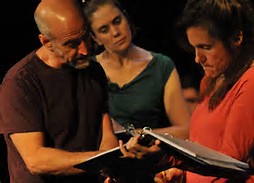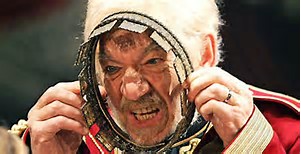

It happens to every director whether they’re a neophyte, a mid-career professional, or a sage veteran. At some point in time, you will find yourself stymied by the fact that you can’t seem to connect with an actor on a specific point, can’t discover the solution to a problematic moment, or are at a loss at what to say regarding a specific challenge. Here are three tips for stage directors who have run into a problem section in a play that they have no idea how to fix.
Identifying the Pivotal Word
If an actor is saying a sentence or phrase and there’s no commitment in how they are saying it, then chances are they’re not sure what that text means or why it is being said. There are many ways to find those important elements that will ultimately give meaning to a line. One

technique is to identify the pivotal or operative word that energizes that line or phrase. Most often it’s a verb, noun, adjective or adverb. But it could be any word in a sentence or phrase.
Have the actor say that pivotal word in a manner different from how they have been saying it and in a way that’s dissimilar to how they have been doing it. Before asking them to do this, discuss the word and why it may be pivotal, its various meanings, and where it sits in the specific speech. You may discover that energy that you need to give the line meaning and importance.
The Trouble Step

When you are dancing with a partner you may utilize something called a trouble step. You use the trouble step when… well… you run into trouble. That is when you’re on the dance floor with others and you find yourself hemmed in. When executing the trouble step if you are leading, you lean forward and then back, staying in the same spot while guiding your partner forward and back. You are moving without moving through the crowd and are, in essence, biding your time. The trouble step buys you time and allows the logjam of bodies that have trapped you to clear a bit so you can once again move around the dance floor.
The directing version of the trouble step is used when you find that your staging is in some manner convoluted and confusing. In other words, the movement of the actors is muddling the meaning and effect of the moment. The trouble step for directors involves having players stand in one place and say their lines, allowing the words they are saying to do the work.
Thus, in employing this technique, you would ask the actors to go back to a specific section of the script and request that they not utilize their blocking this time around. Tell them to take any energy that was being used in the blocking and to infuse it in their lines. Have them play the scene, stop, offer some notes regarding what you saw and heard, and then run it again without movement. You may do this as many times as you feel necessary. Once you’re satisfied with the energy of the lines go back and have the actors rehearse the scene with movement. Tell them that they may do anything they want in the scene. Chances are you’ll see a few movements and moments in this new version that you can use, work, and refine.
Go to the Other Extreme

Is a scene totally frenetic, being played low key, very intensely angry, broad slapstick, or being played in some other type of definable and describable manner? If that’s the case, find a moment in the scene where you feel it is becoming false, stale, or ineffective and have the actors go to the opposite end of the spectrum utilizing a new emotion, intensity, tempo, rhythm, pace, etc. Although you may not end up playing that section in the new manner, it may offer you and the actors insights on how to find more variety, nuance, and energy.
Simple Solutions
The tips designed to offer solutions to stage directors in this piece are fairly simple and, yet, they are effective. Often, simple is the way to go. Focusing on one element, using a specific technique, or isolating a moment can make all the difference in a scene and in your production. Successfully directing a play involves creating thousands upon thousands of individual moments that eventually flow together at alternating, shifting, and changing rhythms, tempos, and paces.
Directing is about bridging gaps between physical action and spoken language, actor and text, and script and production. Once all of those bridges are in place, you’ll have a show that runs on its own energy. The challenge, excitement, and joy of directing is working towards that end with your actors.

 Random Item
Random Item